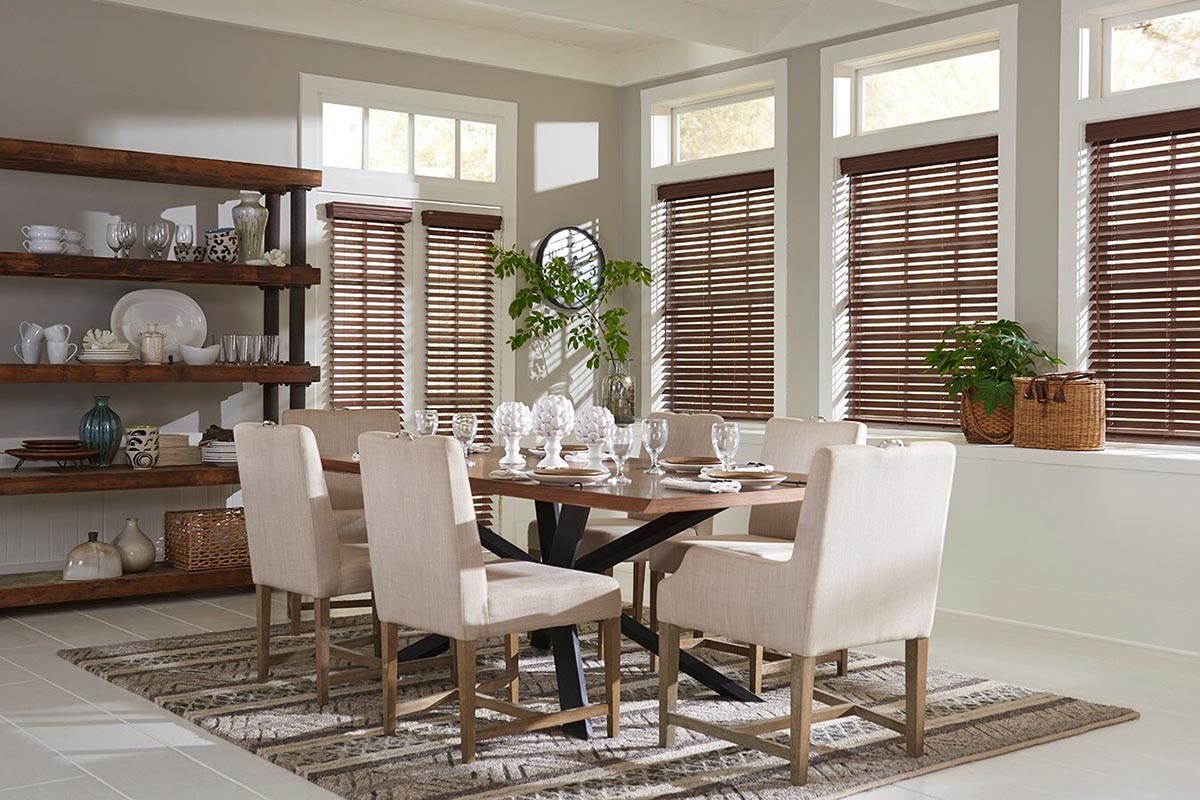We may earn revenue from the products available on this page and participate in affiliate programs. Learn More ›
Whether you’re looking to block light or get some privacy, blinds and shades serve all of that function and can act as the final touch that completes a room. Choices range in size, style, and material, so it’s essential to take measurements and consider design preferences before you begin shopping.
Once you’ve done your homework, the best places to buy blinds online make it relatively easy to sort through thousands of options to find the perfect window treatments. Start your search for a stylish and functional finish with the following popular retailers.
1. The Home Depot
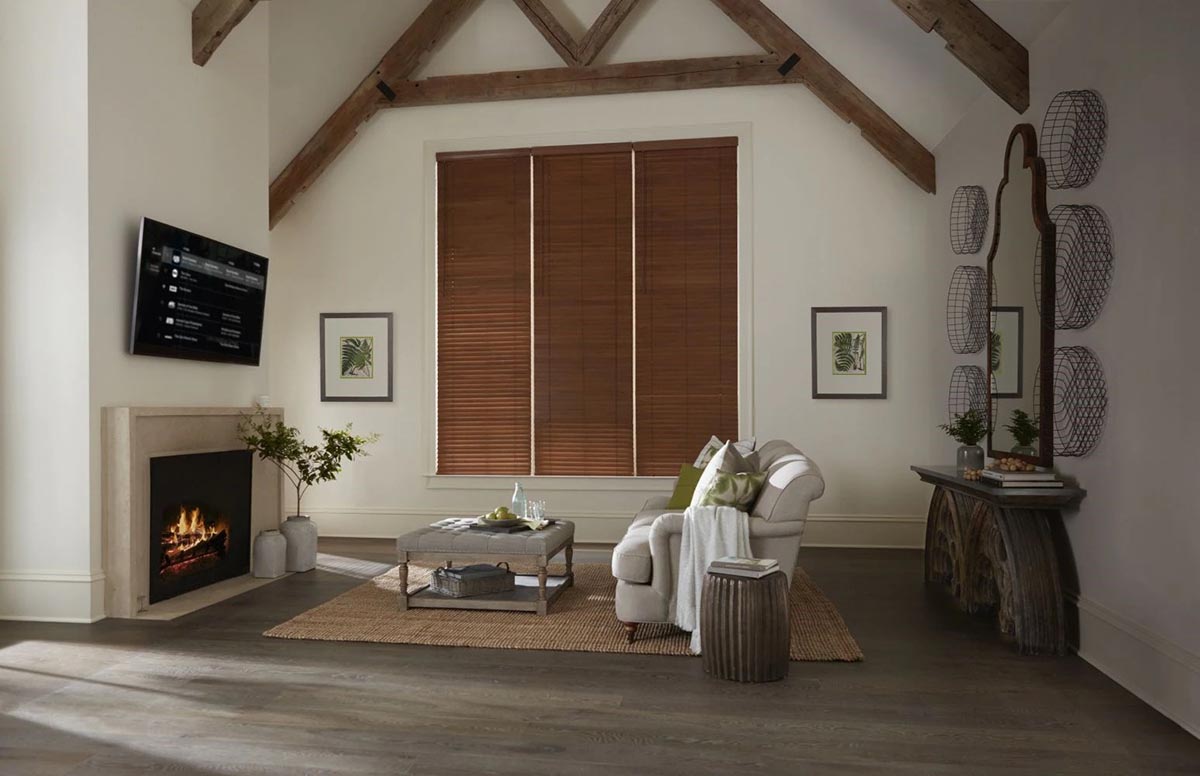
Price Range: $ to $$$
Return Policy: Return new and unopened products in store or online for a full refund up to 90 days of purchase.
Top Products: Levolor 2-Inch Faux Wood Blinds—$33.93+ and White Cordless 1-Inch Vinyl Mini Blinds—$7.98+
As a large home improvement center, The Home Depot carries a wide range of window treatments in their stores but even more online. The blind selection includes various types, including cordless, motorized, cellular, and vertical, all of which can be cut to size inside the store. Blinds can be ordered online for delivery or to be picked up at your local store.
The store’s wide selection means an option for every budget, and regular sales can make selections more affordable. The only drawback is that seemingly unlimited choices might lead to decision paralysis. Luckily, the online navigation lets users narrow it down by material, style, and price.
If measuring and installing window blinds on your own feels overwhelming, The Home Depot offers phone support. Custom-designed blinds and professional installation are available by scheduling an in-home appointment with the store’s home service department.
Shop all The Home Depot blinds
2. Lowe’s
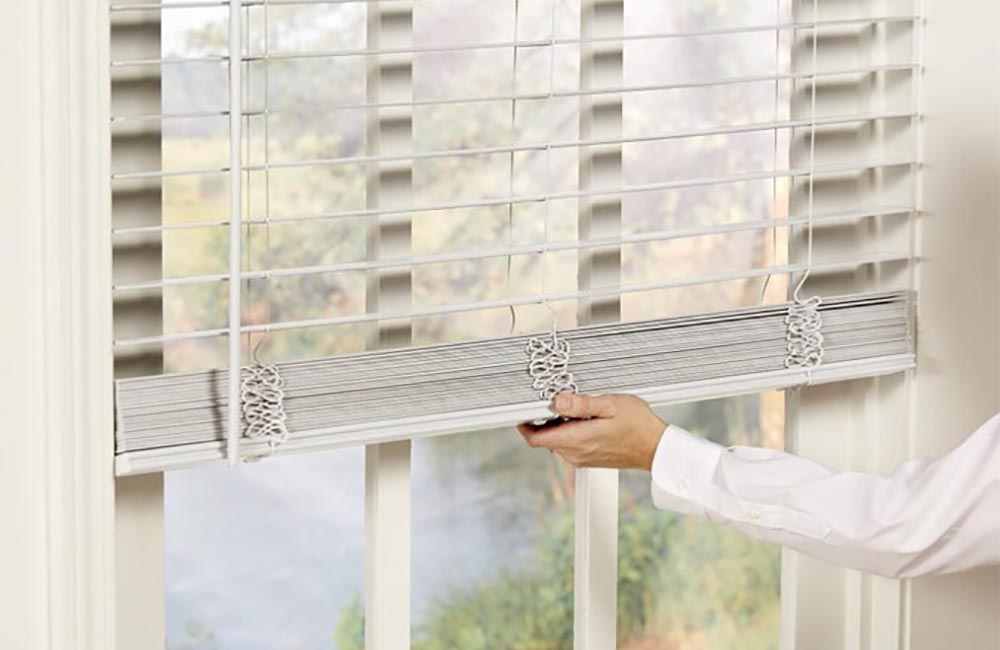
Price Range: $ to $$
Return Policy: Eligible merchandise can be returned within 90 days for a full refund. Return items in store or print a free return label for mail-in refunds.
Top Products: Allen + Roth Cordless Faux Wood 2-Inch Blinds—$28.98+ and Levolor Trim+Go 3.5-Inch Slat Room Darkening Vertical Blinds—$36.98
Like other big home improvement centers, Lowe’s offers a wide selection of blinds, which can be shipped or picked up at the store. Users can select from plenty of stock selections or customizable options, the latter of which is ideal for non-standard window sizes and specific preferences.
To help narrow down the options, users can navigate by style, color, width, length, material, price, light-filtering, and more. If you still can’t decide, Lowe’s will ship up to 10 free swatches. For those who want additional support, the store offers measurement and installation services.
3. Blinds.com
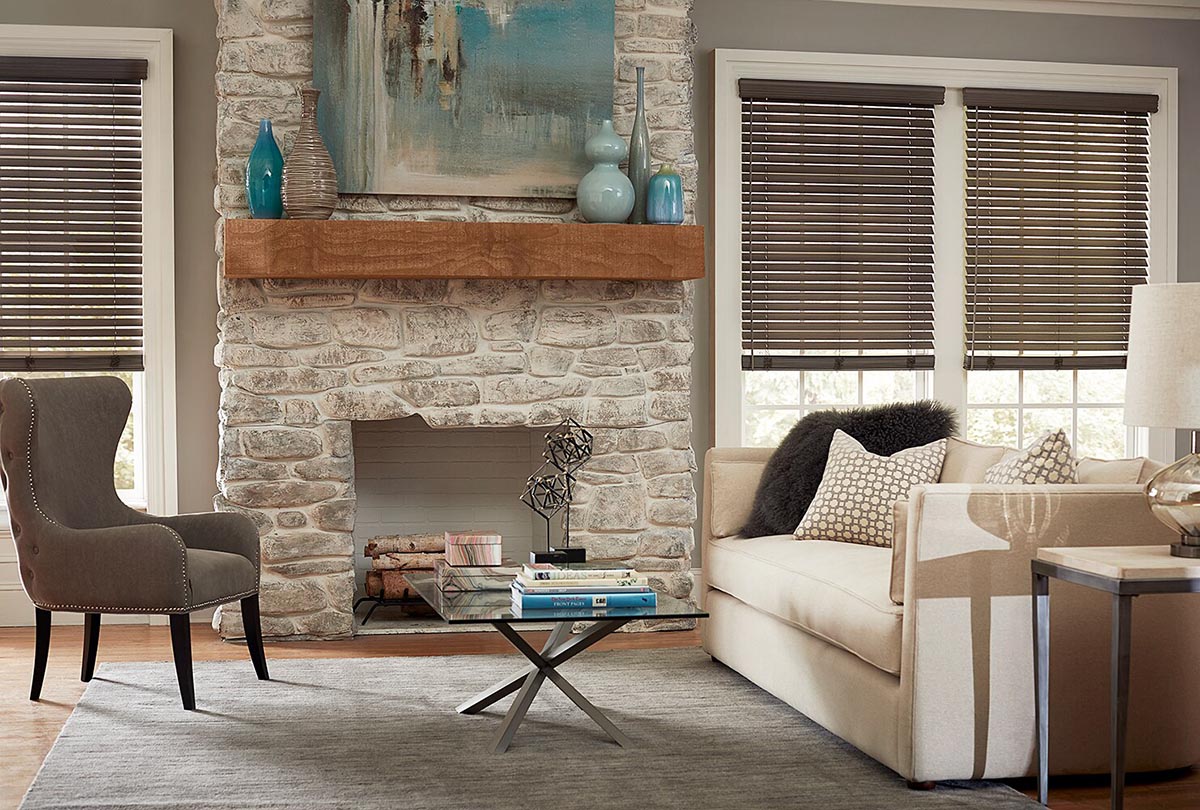
Price Range: $ to $$$
Return Policy: In order to receive a refund for an order, the order must be canceled within 24 hours of when it was placed. However, Blinds.com will work with users who are not satisfied with the way their blinds turned out (color, style, etc.) and will send a replacement product.
Top Products: 2-Inch Faux Wood Blinds—$26.24+ and Bali 2-Inch Vinyl Blinds—$35.99+
A major player in the blinds-selling market, Blinds.com boasts 20 years online and 20 million blinds sold. The Home Depot owns the company, so it carries as many selections as its big-box retailer parent and also offers its own line of blinds. There are frequent promotions running on their site, so buyers can usually find options to suit any budget.
What sets the site apart is its customer service. Shoppers looking for design ideas can peruse the site’s blog and inspiration tips or take advantage of Blinds.com’s free online design consultation. The clean site navigation allows users to search by room, brand, feature, or purpose to narrow down their choices. Blinds.com offers in-home measurement and installation through The Home Depot’s network of professional installers for a set fee.
4. Wayfair

Price Range: $ to $$$
Return Policy: Many items are eligible for a full refund (minus shipping fees in some cases) within 30 days of the delivery date.
Top Products: Wayfair Basics Semi-Sheer Top-Down Bottom-Up Cellular Shade—$28.85+ and Deluxe Sundown Room Darkening Venetian Blinds Name—$26.35
Shoppers who want to buy their curtains, blinds, and accessories all in one click will appreciate Wayfair’s extensive array of design finishes. They don’t specialize in blinds, so the selection is more limited than big-box retailers, but there are still plenty of options available. Wayfair’s products tend to be from lesser-known sellers, so the quality can vary across brands.
Users can search blinds by type and filter selections by size, color, mounting location, light filtration, features, and more. For those who want a little extra help, Wayfair offers a hotline for shopping assistance and expert installation, which can be added to a shopping cart at checkout.
5. Ikea
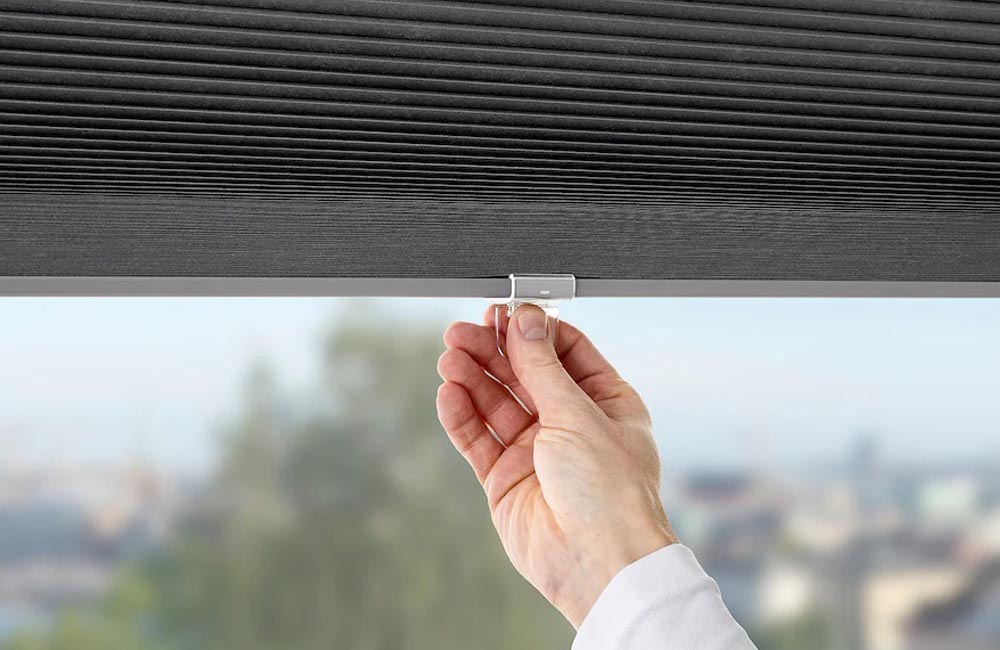
Price Range: $ to $$
Return Policy: Ikea offers full refunds for new and unopened products with a proof of purchase for 365 days. Customers can also receive a full refund for 180 days for opened products with a proof of purchase.
Top Products: Hoppvals Room Darkening Cellular Blind—$29.99 and Trippevals Black-Out Cellular Blind—$55.99
Founded in Sweden in 1943 by a 17-year-old, Ikea is now the world’s largest furniture retailer with 445 stores globally. Recognized for its Scandinavian style, the store sells everything from kitchen cabinets to meatballs. Its selection of blinds is minimal, but the simple and affordable selections are a good choice for modern homes. Options include roller, Roman, cellular, or pleated and are available in standard sizes and neutral colors. Ordering online will save shoppers the time spent navigating the aisles of the company’s huge stores.
Ikea also is known for its complicated furniture assembly, but most of their blinds come easy to install out of the box. There is no option for cutting or installation, so users will have to fend for themselves.
6. Amazon

Price Range: $ to $$
Return Policy: Though the return policies of individual sellers on Amazon can vary, most items shipped from Amazon.com and Amazon warehouses are eligible for a full refund within 30 days of purchase.
Top Products: Chicology Mini Blinds—$13.99+ and Achim Home Furnishings Cordless Light Filtering Mini Blinds—$13.93+
As the top e-commerce platform in the country, Amazon is sure to pop up on any online shopping search. With the site’s most significant benefit being low prices and quick shipping, it is a natural go-to for last-minute shopping. Buyers can track deliveries online or easily cancel the delivery.
Its extensive selection of blinds can be narrowed by brand, size, price, style, material, and cord type. The site also will give side-by-side comparisons between similar products. Quality will vary from seller to seller, but reviews will provide shoppers a good idea of where to start whether they’re looking for blackout blinds, wooden blinds, Venetian blinds, or something else.
7. JCPenney

Price Range: $ to $$$
Return Policy: Return items with a receipt in store or online within 60 days of purchase.
Top Products: Bali Fabric Custom Vertical Blinds—$145+ and Cut-to-Width 2-Inch Cordless Faux-Wood Blinds—$126+
In recent years, this large retailer has closed many stores, so shopping at JCPenney.com is convenient for those who don’t have a nearby location. Their collection of blinds is not as extensive as other retailers, but they carry plenty of choices, including wood and faux wood, cellular, vertical, Roman, and roller options.
Site visitors can search by light filtration, color, control types, installation type, material, and more. Shoppers can make custom selections online, but the company no longer offers in-home design consultation and installation. Once purchased, the blinds can be shipped to your door or picked up in a nearby store.
8. The Shade Store

Price Range: $ to $$$$
Return Policy: The Shade Store will work with customers to make sure they are happy with their purchase—either by remaking flawed products that don’t meet the customer’s expectations or by offering 50 percent off a new product (valid for 30 days following installation) for those who chose the wrong material or product.
Top Products: 2-Inch Designer Wood Blinds—$247+ and 2-Inch Metal Blinds—$247+
The Shade Store was founded with the goal of offering customers a simple alternative to an often otherwise difficult shopping experience. The company’s high-end products don’t come at a low cost, but there are plenty of customer perks. Shoppers can request a free professional measurement or get help from a designer.
Consultations are available in the company’s showrooms or virtually on a computer, smartphone, or tablet. For quick questions, the website has a chat option that lets users talk to designers in real time.For buyers who accidentally ordered the wrong size, the company will cut it down at no charge or offer a replacement at 50 percent off.
The site offers a large selection of blinds made from sustainably sourced real wood. There are more than 70 finishes available in seven collections. To help with selection, The Shade Store will send customers unlimited free samples.
Shop all The Shade Store blinds
9. Blindsonline.com

Price Range: $ to $$$
Return Policy: Returns are not accepted because every blind is custom-ordered. However, damaged or defective blinds can be sent back for repair or replacement.
Top Products: Cordless White 2-Inch Faux Wood Blinds—$37.14+ and Vertical Blinds Smooth PVC—$27.49+
Blindsonline.com is a no-frills discount blind retailer best for those looking for economy-priced options and a DIY experience. There is no option for in-home measurement or installation, but users can call customer service with design questions and for help placing an order.
The company’s website is nothing fancy but can be easily searched by blind type, including cordless blinds, faux wood blinds, wooden blinds, mini blinds, and more. Most of the options sold on the site are the company’s own Blindsonline.com brand. Once shoppers place an item in their cart, they can customize their selection by inputting mounting type, color, and size requests.
Shop all Blindsonline.com blinds
10. Just Blinds

Price Range: $ to $$
Return Policy: Returns are only accepted on a case-by-case basis and must be pre-authorized by Just Blinds.
Top Products: Faux Wood Blinds—$28+ and Aluminum Blinds—$23.20+
Just Blinds is another top retailer when you’re looking to buy blinds online. What started in 1999 as a home-based business more than 20 years ago has since grown to become one of the largest retailers for window coverings in the United States. To date, Just Blinds has served more than 1 million customers.
In addition to blinds, Just Blinds also sells shades and shutters—despite what their company name may have you believe. Their website makes it easy to compare the different product types, lengths, widths, materials, and color options available. Once you find something you think you like, take advantage of their free samples to see how the blinds will actually look in your space. Just Blinds doesn’t have any physical storefront or showroom locations, which helps keep their overhead down and allows them to offer reasonably-priced, high-quality products. In most cases, orders ship within 5 to 7 business days and include free shipping.
11. Overstock.com

Price Range: $ to $$
Return Policy: New and unused items are eligible for a return within 30 days of delivery (shipping costs may apply).
Top Products: Arlo Blinds White Cordless Faux Wood Blinds with Royal Valance—$35.54+ and 1-Inch White Cordless Vinyl Mini Blind —$18.53+
Overstock has built a reputation over the past 20+ years as an online retailer specializing in discounts on returned and surplused merchandise from other companies. Today, Overstock continues to sell close-out and surplus merchandise, but they also offer various new products for the home, including furniture, rugs, lighting, bedding, and window coverings.
The blinds and shades section of the website pulls up more than 800 results. Use the filters along the side of the page to narrow your focus based on the size of your window, your preferred colors or materials, budget, and more. Orders placed through Overstock.com include free shipping to the 48 contiguous United States.
12. Blinds To Go

Price Range: $ to $$$$
Return Policy: Contact Blinds To Go within 30 days of purchase to receive a replacement (or equal value) or a return. Prior authorization for returns is required, and there is a limit of one replacement or refund for each product (with a limit of 10 items per household).
Top Products: Faux Wood Blinds—$47.02+ and Wood Blinds—$90.65+
Blinds To Go’s history traces back more to 1951 when David Shiller started driving the family station wagon around to sell goods door to door. Today, Blinds to Go is one of the top manufacturers of window coverings in North America. The company has three factories—in New Jersey, Maryland, and Montreal—where they manufacture the blinds, shades, drapes, and shutters they sell. Shop online any time, or visit one of the 80 showrooms across the United States and Canada.
The selection of blinds offered by Blinds to Go is quite expansive. You can choose from a variety of materials—such as wood, faux wood, and aluminum. Within each material type, you’ll find that there are numerous styles, sizes, and color options available. Customize the blinds you order to match the exact specifications of the space and your design preferences for a truly custom look.
How We Chose the Best Places to Buy Blinds Online
Narrowing down the many online retailers that sell blinds to the list above was not an easy task. While researching the different companies that sell blinds, we compared a number of features to help decide which companies would ultimately make the final list. The reputation and customer service provided by each company was closely considered to help ensure customer satisfaction.
One of the next most important features we considered was product selection. We sought to include companies that offered blinds in a variety of materials, colors, styles, and sizes to best match the needs of different customers. Finally, we also tried to include manufacturers that offer quality blinds to match different budgets.

